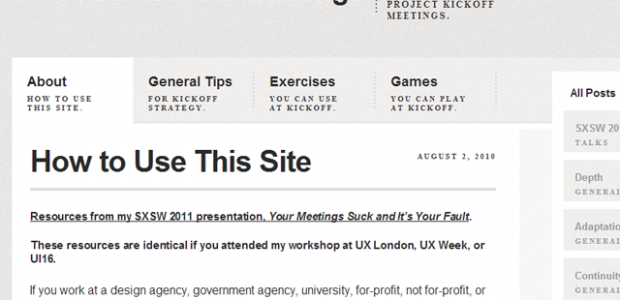
Discovery sessions, or kickoff meetings, are a great way to initiate a new project.
On his site Good Kickoff Meetings, SXSW speaker and UX designer Kevin Hoffman has compiled a bunch of tips and exercises that help projects get off to a strong start.
One of my favourite tips is the frontloaded stakeholder interview:
“Consider conducting your full stakeholder interview phase before you hold your kickoff meeting. This provides content for kickoff exercises and a framework for you to test the expectations of stakeholders against the larger organization.”
This tip got my thinking about the questions that I ask when starting on new web projects.
Smaller projects, similar ideas.
The organizations that I work with are smaller — local artists, for example — but I feel that the objectives are similar to what Hoffman is touching on.
We’re both trying to accomplish three things in this initial phase:
- Build a personal relationship with the client.
- Determine technical requirements for the site.
- Identify potential problem areas or limitations.
Additionally, I find this to be a good opportunity to qualify the client:
- Are they someone I can work with?
Everything else about the project may be great, but minor incompatibilities can become insufferable conflicts when you add time and pressure.
Luckily in those situations I can refer the client to someone else, while still leaving them with valuable takeaways from the discovery session.
What questions do I ask?
We start off with some background information:
- Tell me about yourself, and what you do.
- What’s your story? What got you into this?
- Tell me about your business/organization.
- Why was this organization started? What’s the vision? What products or services are you providing?
- Tell me about your website. Where’s it at now? What do you like? What don’t you like? What sort of experience do you want visitors to have?
Next, we move onto project objectives and target audiences:
- What are your goals?
- These are specific, organization-level goals that the website should have an impact on.
They can be hard goals (measurable), like an increase in sales. They can also be soft goals (immeasurable), like sustaining relationships with current customers.
Hoffman has a good point related to this: “What is the one thing we must get right to make the project worth undertaking?”
- These are specific, organization-level goals that the website should have an impact on.
- Who are you targeting?
- Identify the audiences that will use the website. These aren’t always obvious or top-of-mind, either.
Competitors, the media, and the general public are all audiences that will potentially use the site.
- Identify the audiences that will use the website. These aren’t always obvious or top-of-mind, either.
- How are you reaching your audiences now?
- What are the channels you’re using to reach your audiences right now?
How are people hearing about you?
- What are the channels you’re using to reach your audiences right now?
- What are you asking them to do?
- Associate an objective — a call to action — with each audience group.
e.g.) you want qualified visitors to make a purchase, or you want non-purchasers to refer a friend.
These CTAs should be tied to the stated goals.
- Associate an objective — a call to action — with each audience group.
After our objectives and targets, we identify requirements:
- What specific requirements do you have? Prioritize them.
Divided into three categories: Appearance, Functionality, and Content.- Appearance is the look and feel of the website, e.g.) colour schemes and fonts.
- Functionality are the things people can do on the site. e.g.) register an account, make a purchase.
- Content addresses all the “stuff”. e.g.) pages, media.
These requirements will feed directly into creating the project proposal.
With the vision crafted, the final questions focus on determining what can actually be accomplished:
- What are your deadlines?
- Some projects are dependent on tight timelines, while others are more flexible.
Understanding when things need to be completed — and for what reason — can help us set expectations with the client.
- Some projects are dependent on tight timelines, while others are more flexible.
- How much time can you invest?
- The beauty of WordPress is that it’s (relatively) simple to manage as a user. But it does have a learning curve.
The client should be willing to invest time into learning how to use their new site, even if it’s just an hour or two a week.
- The beauty of WordPress is that it’s (relatively) simple to manage as a user. But it does have a learning curve.
- What’s the budget for this project?
- The budget helps us determine how much can be done, and by whom.
For tighter budgets, I often find myself saying “it doesn’t mean no; it means not yet“.
- The budget helps us determine how much can be done, and by whom.
The conversation will inevitably diverge from these points as you get into a back-and-forth chat.
That’s not a problem, as long as you’ve hit on the main points. From here, you can start working on writing the project proposal.
What questions should you be asking?
Think about the information that would help your own projects get off to a better start.
What questions could you ask to gather that information? Write those questions down.
From there, consider putting together a template or form based on those questions, something that can be kept on file or even bundled as an appendix to the project proposal.
